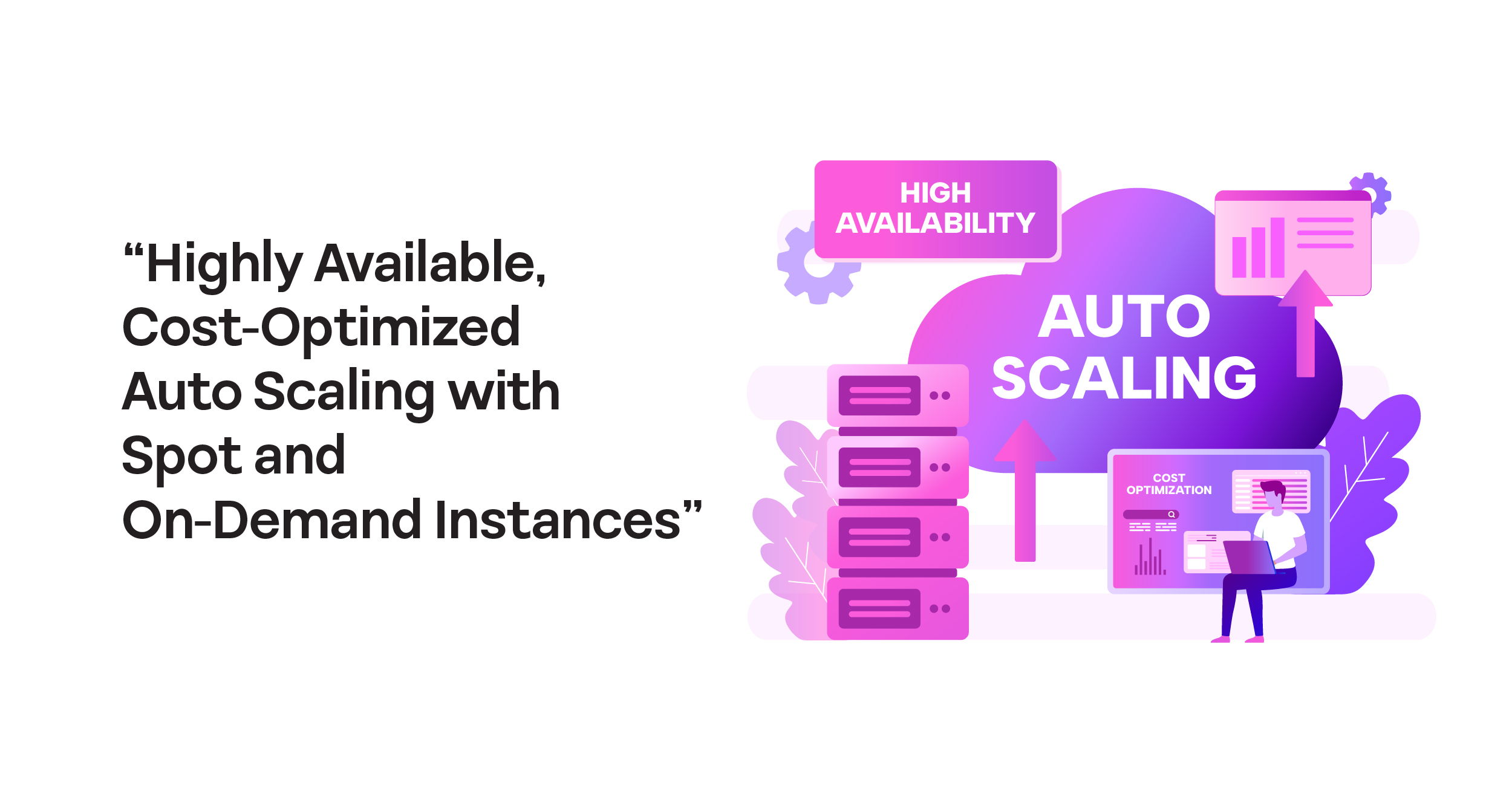Highly Available, Cost-Optimized Auto Scaling with Spot and On-Demand Instances
By Khushi Carpenter, Piyush Jalan / May 06, 2025
Contents
- Introduction
- Solution Overview
- Use Case Example
- 1. Create a Mixed Instances Auto Scaling Group (ASG)
- 2. Build the Lambda Spot Watcher
- 3. Schedule with EventBridge
- 4. Track Results in Cost Explorer
- Results
- Conclusion
Introduction
AWS EC2 Spot Instances can reduce cloud bills by up to 90%, though this comes with the risk of potential interruptions. A predictive auto-scaling strategy can deliver these savings without introducing downtime.
This approach monitors Spot market conditions and pre-emptively switches to On-Demand EC2 when interruption risk rises—providing:
- Maximum cost savings
- Zero downtime
- Fully automated logic
Solution Overview 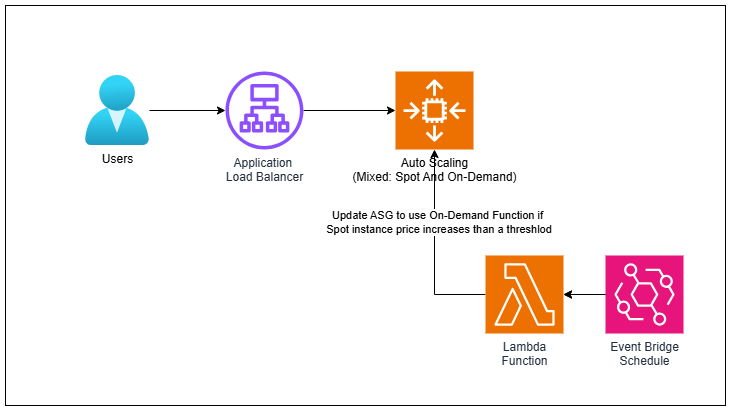
This solution uses a serverless AWS Lambda function to:
- Monitor Spot instance pricing via ec2:DescribeSpotPriceHistory
- Dynamically adjust Auto Scaling Group (ASG) instance mix
- Optionally send alerts (e.g., Slack) when switching occurs
Key Architecture Features:
- Mixed Instances Policy in the ASG
- Lambda-based Spot price monitor
- Scheduled execution using EventBridge
- Slack notifications for visibility
Outcome: A self-adjusting compute layer that ensures uptime while optimizing cost.
Use Case Example
1. Create a Mixed Instances Auto Scaling Group (ASG)
Launch Template
The following configurations are essential when creating the launch template:
- For Instance Type, select ‘Don’t Include in the Template’
- For Purchasing Type, select ‘Don’t Include in the Template’
Auto Scaling Group
To set up an Auto Scaling Group with a mix of Spot and On-Demand instances, use the following steps:
- Go to AWS Console, search for EC2 and select Auto Scaling Group.
- Select create and choose options as below:
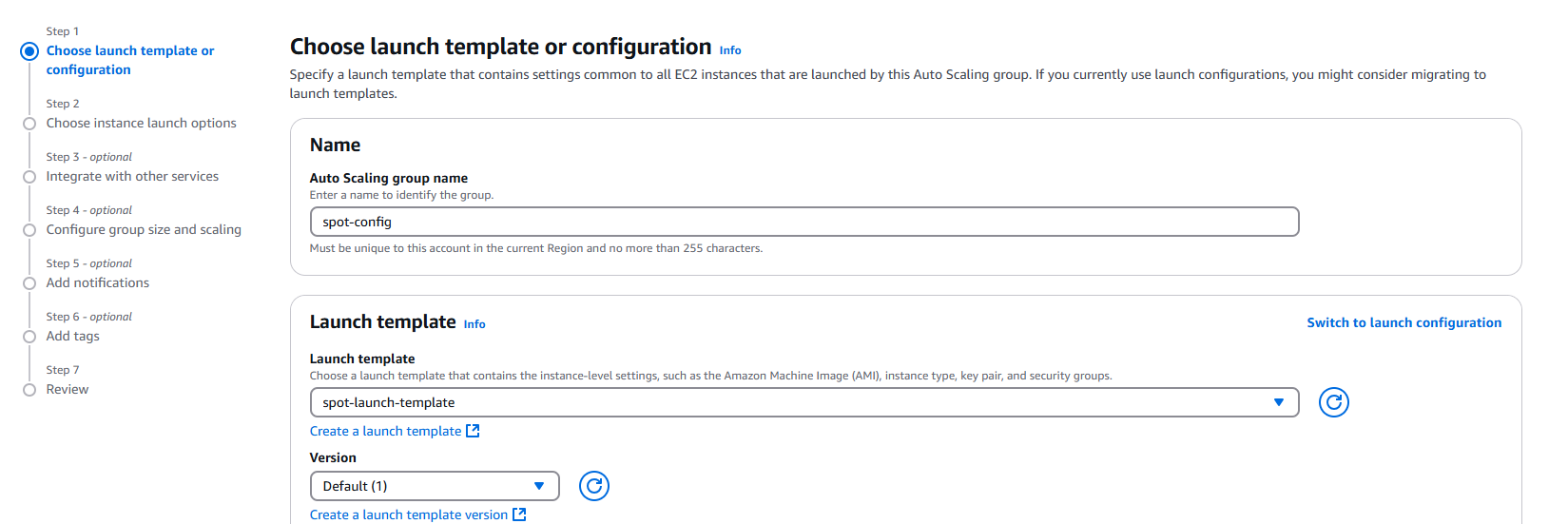
- Click on next, and configure following Instance Options: The On-Demand base is set to 0 as to run the workload mostly on Spot Instances.

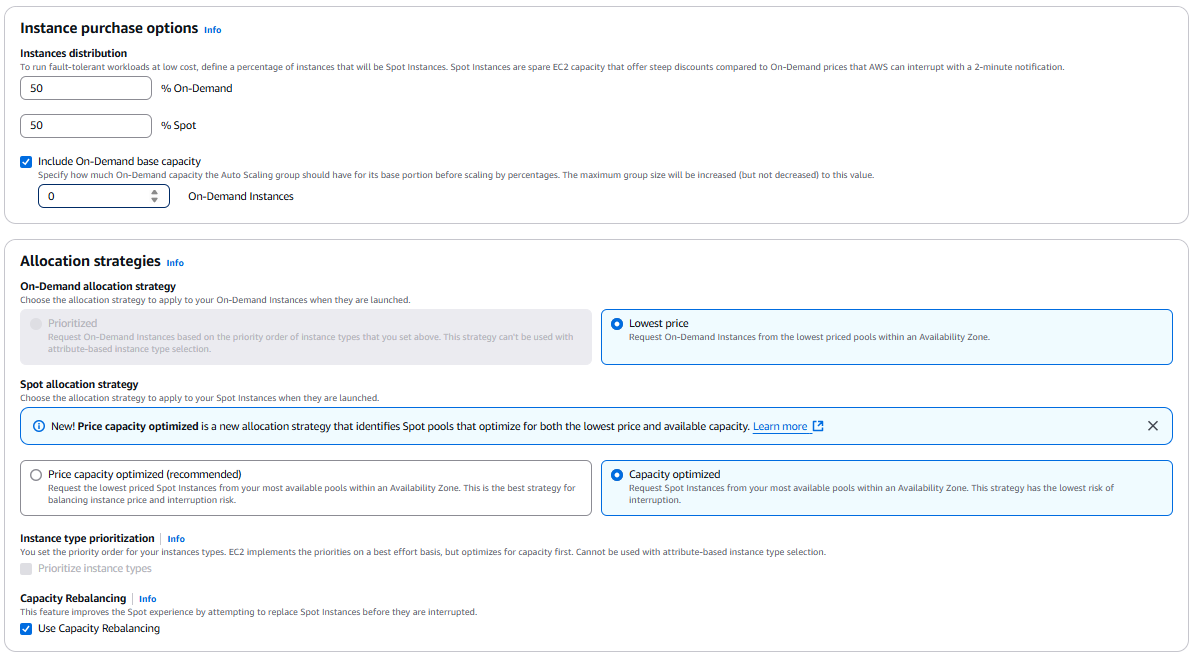
- Click on next, and configure following Network Options:
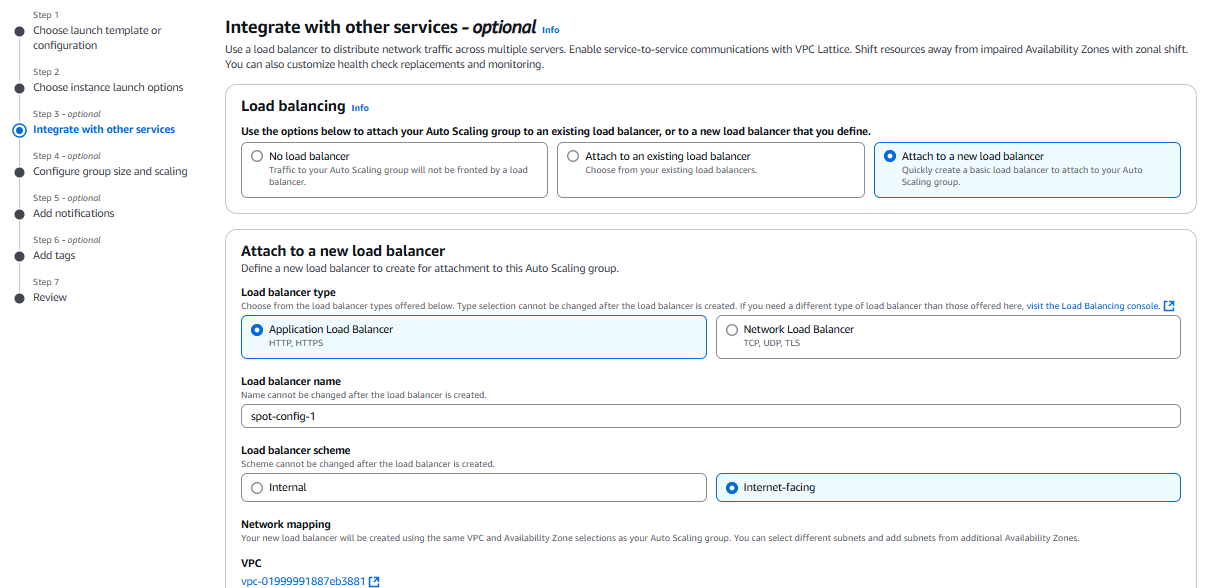
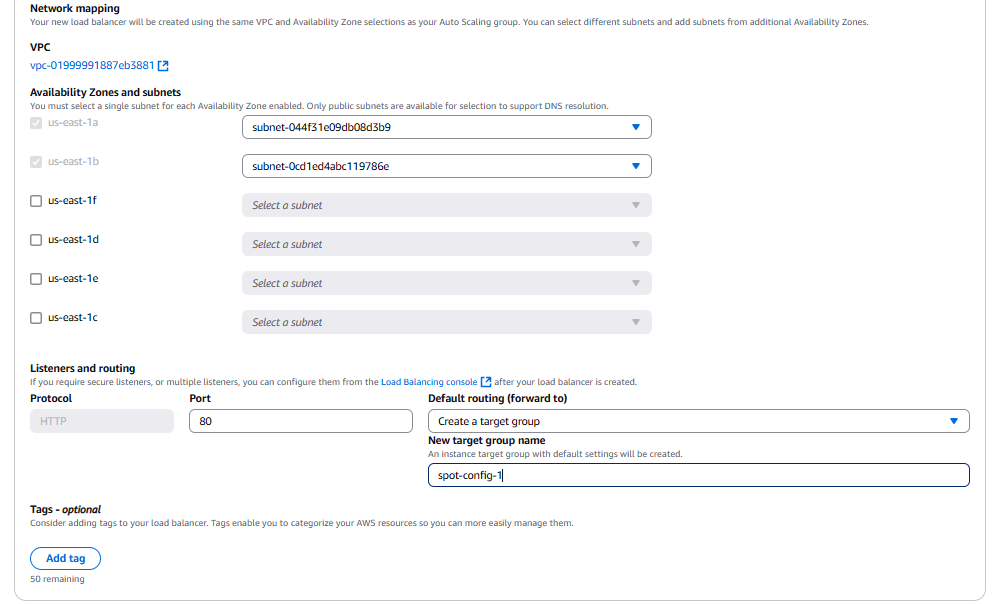
- Click on next, and configure following Scaling Options:
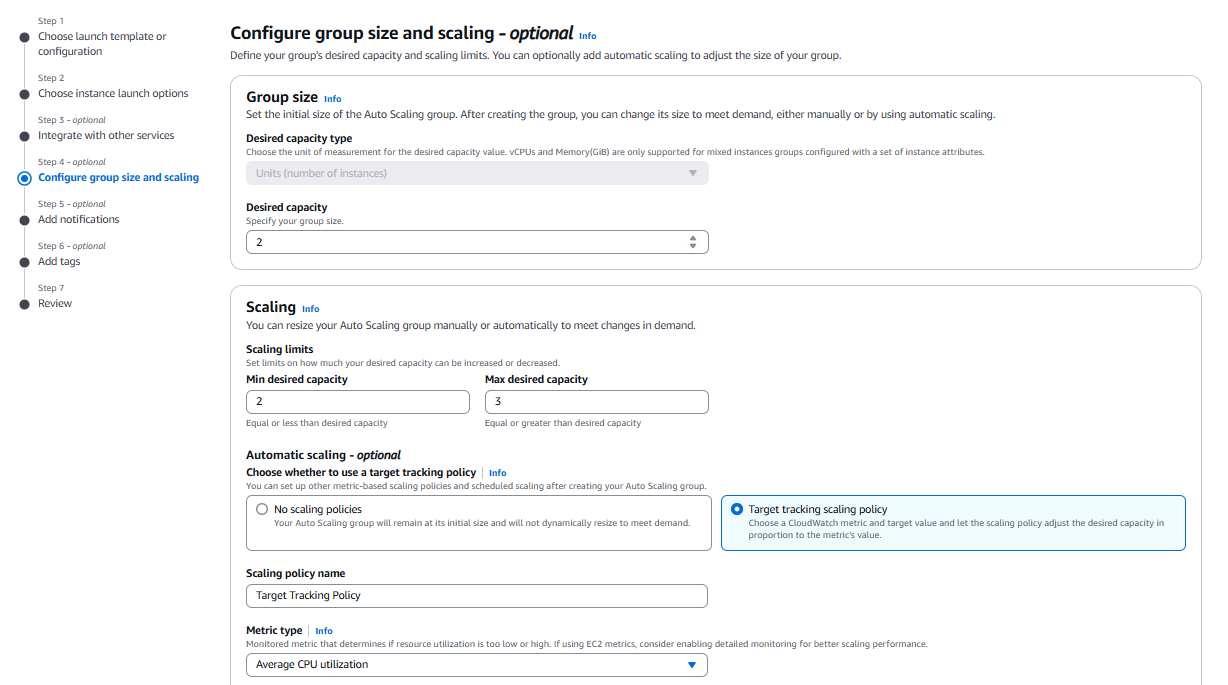
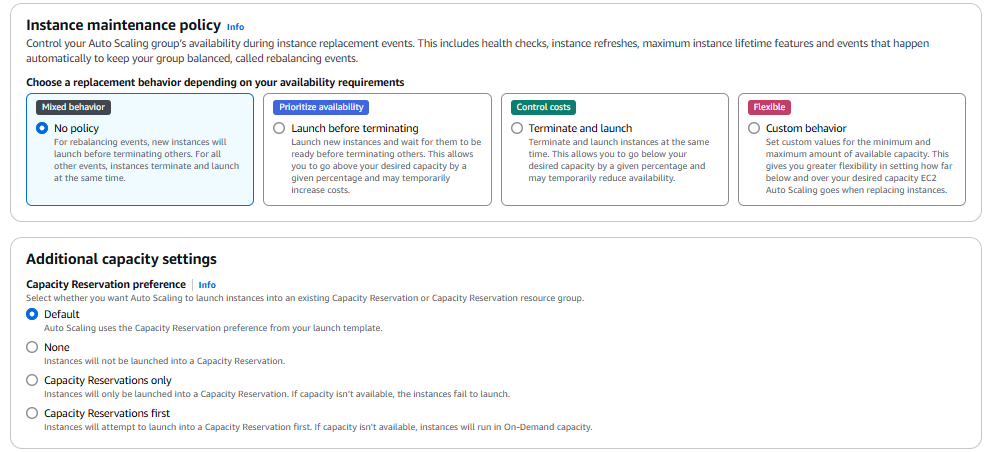
2. Build the Lambda Spot Watcher
A Python-based Lambda function performs the following:
- Retrieves recent Spot pricing
- Compares against a configurable PRICE_THRESHOLD
- If pricing exceeds the threshold → switch to 100% On-Demand
- If pricing is stable → revert to 50/50 Spot-On-Demand split
{
"Effect": "Allow",
"Action": [
"ec2:DescribeSpotPriceHistory",
"autoscaling:UpdateAutoScalingGroup",
"autoscaling:DescribeAutoScalingGroups"
],
"Resource": "*"
}
if spot_price > threshold:
update_asg(100) # All On-Demand
else:
update_asg(50) # Half Spot, Half On-Demand
Slack Webhook integration is optional for alerting.
Lambda Environment VariablesIn the Lambda console, go to Lambda Function, Configurations and Environment Variables:
- INSTANCE_TYPE = t3.medium
- ASG_NAME = your-asg-name
- PRICE_THRESHOLD = 0.05
- AZ = us-east-1a
- SLACK_WEBHOOK = (optional)
Lambda Code
import boto3
import datetime
import os
import requests
# AWS clients
ec2 = boto3.client('ec2')
asg = boto3.client('autoscaling')
# Configuration from environment variables
INSTANCE_TYPE = os.getenv("INSTANCE_TYPE", "t3.medium")
ASG_NAME = os.getenv("ASG_NAME", "example-asg")
PRICE_THRESHOLD = float(os.getenv("PRICE_THRESHOLD", "0.05"))
AVAILABILITY_ZONE = os.getenv("AZ", "us-east-1a")
SLACK_WEBHOOK = os.getenv("SLACK_WEBHOOK")
def get_latest_spot_price():
"""Fetches the latest Spot price for the specified instance type and AZ."""
now = datetime.datetime.utcnow()
prices = ec2.describe_spot_price_history(
InstanceTypes=[INSTANCE_TYPE],
ProductDescriptions=['Linux/UNIX'],
StartTime=now - datetime.timedelta(minutes=15),
EndTime=now,
AvailabilityZone=AVAILABILITY_ZONE,
MaxResults=1
)
if prices['SpotPriceHistory']:
return float(prices['SpotPriceHistory'][0]['SpotPrice'])
else:
raise Exception("No Spot price history available.")
def update_asg(on_demand_percent):
"""Updates the ASG with a new On-Demand percentage."""
response = asg.update_auto_scaling_group(
AutoScalingGroupName=ASG_NAME,
MixedInstancesPolicy={
'InstancesDistribution': {
'OnDemandPercentageAboveBaseCapacity': on_demand_percent,
'SpotAllocationStrategy': 'capacity-optimized'
}
}
)
return response
def send_alert(message):
"""Sends an optional Slack alert."""
if SLACK_WEBHOOK:
try:
requests.post(SLACK_WEBHOOK, json={"text": message})
except Exception as e:
print(f"[ERROR] Failed to send Slack alert: {e}")
def lambda_handler(event, context):
"""Main Lambda entry point."""
try:
price = get_latest_spot_price()
print(f"[INFO] Current Spot Price: ${price:.4f}")
if price > PRICE_THRESHOLD:
update_asg(100) # All On-Demand
msg = (
f"Spot price is ${price:.4f}, above threshold (${PRICE_THRESHOLD}). "
f"Switched ASG '{ASG_NAME}' to 100% On-Demand to preserve uptime."
)
else:
update_asg(50) # 50% Spot, 50% On-Demand
msg = (
f"Spot price is ${price:.4f}, below threshold (${PRICE_THRESHOLD}). "
f"Using 50% Spot in ASG '{ASG_NAME}' for optimized savings."
)
print(msg)
send_alert(msg)
except Exception as e:
error_msg = f"[ERROR] {str(e)}"
print(error_msg)
send_alert(f"Lambda error in spot_monitor: {str(e)}")
3. Schedule with EventBridge
Run Lambda on a 5-minute interval for continuous responsiveness. To setup the event bridge use following CLI commands:
- aws events put-rule \ --schedule-expression "rate(5 minutes)" \ --name SpotMonitorSchedule
- aws events put-targets \ --rule SpotMonitorSchedule \ --targets "Id"="1","Arn"="{your-lambda-arn}"
4. Track Results in Cost Explorer
AWS Cost Explorer can visualize usage trends, highlighting reduced costs during Spot usage and stable operation during On-Demand transitions.
Results
Expected outcomes from this solution:
- Significant cost savings, with up to 90% reduction in EC2 spend during Spot usage.
- Maintained uptime through proactive switching to On-Demand before Spot instance interruptions.
- Improved visibility via real-time alerts that notify of instance mix changes.
- Automatic recovery by reverting to Spot usage when pricing stabilizes.
- Reduced operational overhead with fully automated scaling decisions.
Conclusion
A predictive auto-scaling model eliminates the trade-off between savings and reliability.
- Spot usage during stable market conditions.
- On-Demand fallback during spikes.

